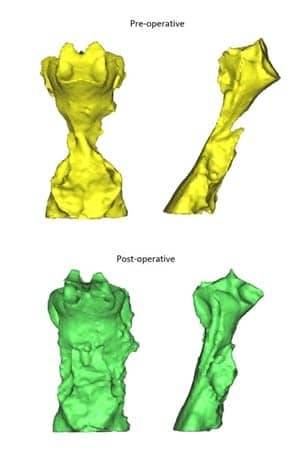Jaw advancement surgery can be an effective treatment for obstructive sleep apnea, but it can change facial appearance and bite, especially among East Asians who typically have more prominent lips than Caucasians. This makes it difficult to perform jaw advancement surgery without compromising the facial aesthetics of patients.
The Oral and Maxillofacial Surgery research team at The University of Hong Kong (HKU) School of Dentistry recently conducted a pilot study to measure whether a new jaw surgery technique could help improve moderate to severe obstructive sleep apnea. OSA).
The findings were published in International Journal of Oral and Maxillofacial Surgeryindicate that this jaw surgery can significantly relieve sleep apnea and maintaining or even improving the patient’s appearance.
All patients in the study with moderate to severe OSA had a 50% or greater reduction in breathing disturbances at night after surgery, and 58% of patients were considered cured, with no signs of sleep apnea.
The jaw surgery technique involves a multi-part osteotomy (cutting and reshaping of the bone) of the mandible called segmental mandibular advancement (SMA). It is a combination of a procedure to lift part of the front jaw to create space and a procedure to advance the entire lower jaw.

The operation is performed to bring about significant widening of the skeletal airway at the base of the tongue, as well as an attractive facial esthetics and functional bite outcome.
The team’s lead researcher, Mike YY Leung, BDS, MDS, PhD (HK)clinical associate professor of oral and maxillofacial surgery, says this multi-part jaw correction surgery, as adopted in segmental mandibular growth, has been used to correct facial deformities in Hong Kong for many years, but the study makes them several steps forward.
“It was the first study to demonstrate that SMA could also effectively bring about improvement in OSA,” he says in a release. “The uniqueness of the facial features in the East Asian population was the reason for using this method, which takes into account the aesthetics and function of the jaw in addition to the significant expansion of the airways.”
Twelve patients in Hong Kong with moderate to severe sleep apnea, referred by different dentists, general practitioners and ENT specialists were evaluated for this study. They received SMA as a major part of their jaw growth surgery.
The study found that surgery helped improve the preoperative apnea-hypopnea index (AHI) from 42.4 events per hour to 9 events per hour on average at one year postoperatively.
Surgical success, as defined by a reduction in baseline AHI of 50% or more, was seen in 11 of 12 patients. Surgical cure, as defined by an AHI of less than 5 events per hour, was also observed in 7 of 12 patients.
On average, airway volume was also found to increase by 2.8 times after surgery, allowing patients to breathe better. These figures remained stable over the one-year study period.
There was no incidence of major complications in jaw surgery, thus showing that SMA is potentially a safe and effective procedure for patients with severe obstructive sleep apnea.
Joan CC Wan, a co-investigator on the project, says the study’s findings are encouraging, showing significant improvement even in severe cases of OSA as well as consistent results.
“We believe that the pilot study has set the cornerstone for a larger-scale study that can observe the long-term results of this technique and help us compare it with other treatment methods for OSA,” Wan says in a release.
Top photo: 3D surgical planning of the SMA as part of jaw advancement surgery for patients with severe obstructive sleep apnea.

